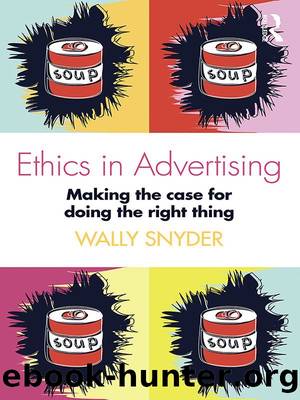Ethics in Advertising: Making the case for doing the right thing by Wally Snyder

Author:Wally Snyder [Snyder, Wally]
Language: eng
Format: azw3
Publisher: Taylor and Francis
Published: 2016-11-02T16:00:00+00:00
Native Advertising: A Guide for Business, FTC, December, 201513
I Established Principles that Support the FTC’s Approach to Native Advertising
Under the FTC Act, an act or practice is deceptive if there is a material misrepresentation or omission of information that is likely to mislead the consumer acting reasonably in the circumstances. A misrepresentation is material if it is likely to affect consumers’ choices or conduct regarding an advertised product or the advertising for the product.
In evaluating whether an ad is deceptive, the FTC considers the net impression the ad conveys to consumers. Because ads can communicate information through a variety of means—text, images, sounds, etc.—the FTC will look to the overall context of the interaction, not just to elements of the ad in isolation. Put another way, both what the ad says and the format it uses to convey that information will be relevant. Any clarifying information necessary to prevent deception must be disclosed clearly and prominently to overcome any misleading impression.
A basic truth-in-advertising principle is that it’s deceptive to mislead consumers about the commercial nature of content. Advertisements or promotional messages are deceptive if they convey to consumers expressly or by implication that they’re independent, impartial, or from a source other than the sponsoring advertiser—in other words, that they’re something other than ads. Why would it be material to consumers to know the source of the information? Because knowing that something is an ad likely will affect whether consumers choose to interact with it and the weight or credibility consumers give the information it conveys.
Over the years, the FTC has brought many cases challenging the format of ads as deceptive. For example, the Commission has taken action against ads that deceptively mimicked the format of news programming or otherwise misrepresented their source. Other cases focused on misleading “door openers”—promotions with a format that deceived consumers about the nature of the transaction—for example, telemarketers who misleadingly suggested they were calling on behalf of a consumer’s credit card company or bank. (The Commission has held that when the first contact between a seller and a buyer occurs through a deceptive practice, the law may be violated even if the consumer later finds out the truth.) Or, as the FTC Endorsement Guides establish, advertisers’ use of third-party endorsements may be deceptive if there is an undisclosed material connection between the advertiser and the endorser—one that might materially affect the weight or credibility of the endorsement. The FTC considers misleadingly formatted ads to be deceptive regardless of whether the underlying product claims that are conveyed to consumers are truthful.
The particular forms native advertising takes in the digital marketplace may be new, but the FTC’s Enforcement Policy Statement makes clear that the FTC applies the same truth-in-advertising principles it has used for decades to evaluate whether the format of an ad is deceptive. In the context of native advertising, if the source of the content is clear, consumers can make informed decisions about whether to interact with the ad and the weight to give the information conveyed in the ad.
Download
This site does not store any files on its server. We only index and link to content provided by other sites. Please contact the content providers to delete copyright contents if any and email us, we'll remove relevant links or contents immediately.
| Advertising | Consumer Behavior |
| Customer Service | Marketing |
| Public Relations | Sales & Selling |
| Search Engine Optimization |
Influence: The Psychology of Persuasion by Robert B. Cialdini(4178)
The Miracle Morning by Hal Elrod(3909)
The Hacking of the American Mind by Robert H. Lustig(3579)
Pre-Suasion: A Revolutionary Way to Influence and Persuade by Robert Cialdini(3413)
Unlabel: Selling You Without Selling Out by Marc Ecko(2981)
Hidden Persuasion: 33 psychological influence techniques in advertising by Marc Andrews & Matthijs van Leeuwen & Rick van Baaren(2777)
Who Can You Trust? by Rachel Botsman(2732)
Kick Ass in College: Highest Rated "How to Study in College" Book | 77 Ninja Study Skills Tips and Career Strategies | Motivational for College Students: A Guerrilla Guide to College Success by Fox Gunnar(2719)
Purple Cow by Seth Godin(2697)
Ogilvy on Advertising by David Ogilvy(2682)
I Live in the Future & Here's How It Works by Nick Bilton(2524)
This Is Marketing by Seth Godin(2482)
The Marketing Plan Handbook: Develop Big-Picture Marketing Plans for Pennies on the Dollar by Robert W. Bly(2413)
The Power of Broke by Daymond John(2376)
Building a StoryBrand by Donald Miller(2360)
The 46 Rules of Genius: An Innovator's Guide to Creativity (Voices That Matter) by Marty Neumeier(2308)
Draw to Win: A Crash Course on How to Lead, Sell, and Innovate With Your Visual Mind by Dan Roam(2277)
The Tipping Point by Malcolm Gladwell(2204)
Market Wizards by Jack D. Schwager(2163)
